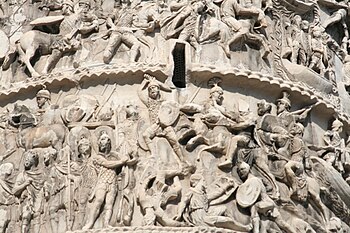
Back حروب ماركومانية Arabic Markoman müharibələri Azerbaijani Маркаманская вайна Byelorussian Маркоманска война Bulgarian Guerres Marcomanes Catalan Markomanské války Czech Маркоман вăрçи CV Markomannenkriege German Guerras marcomanas Spanish Guerres marcomanes French
| Marcomannic Wars | |||||||||
|---|---|---|---|---|---|---|---|---|---|
| Part of the Roman–Germanic Wars | |||||||||
 Detail of a relief scene on the Column of Marcus Aurelius (in Rome, Italy), depicting a battle of the Marcomannic Wars, late 2nd century AD | |||||||||
| |||||||||
| Belligerents | |||||||||
| Roman Empire |
Principal Belligerents: | ||||||||
| Commanders and leaders | |||||||||
|
Imperial family: Marcus Aurelius Lucius Verus # Tiberius Claudius Commodus Praetorian prefects: Titus Furius Marcus Rufus Marcus Macrinius † Publius Paternus Field marshals (legati): Publius Helvius Pertinax Marcus Claudius Fronto † Marcus Didius Julianus Gaius Pescennius Niger Decimus Clodius Albinus M. Valerius Maximianus Lucius Gallus Julianus Gaius Vettius Sabinianus Titus Vitrasius Pollio |
Marcomanni: Ballomar Quadi: Ariogaesus Iazyges: Banadaspus Zanticus Naristi: Valao | ||||||||
| Units involved | |||||||||
| Full list of participating military units | Unknown | ||||||||
| Strength | |||||||||
| 977,000[a] | ||||||||
| Casualties and losses | |||||||||
| Moderate | Heavy | ||||||||
The Marcomannic Wars (Latin: bellum Germanicum et Sarmaticum[b] German and Sarmatian war) were a series of wars lasting from about AD 166 until 180. These wars pitted the Roman Empire against principally the Germanic Marcomanni and Quadi and the Sarmatian Iazyges; there were related conflicts with several other Germanic, Sarmatian, and Gothic peoples along both sides of the whole length of the Roman Empire's northeastern European border, the river Danube.
The struggle against the Germans and Sarmatians occupied the major part of the reign of Roman emperor Marcus Aurelius, and it was during his campaigns against them that he started writing his philosophical work Meditations.[c]
Cite error: There are <ref group=lower-alpha> tags or {{efn}} templates on this page, but the references will not show without a {{reflist|group=lower-alpha}} template or {{notelist}} template (see the help page).
- ^ Kovács 2009, pp. 202–203.
- ^ Marcus Aurelius 2007.